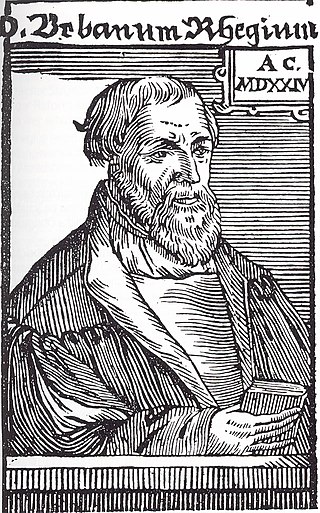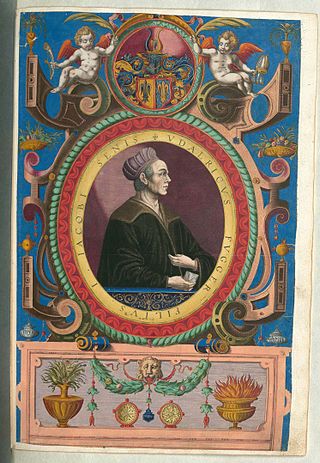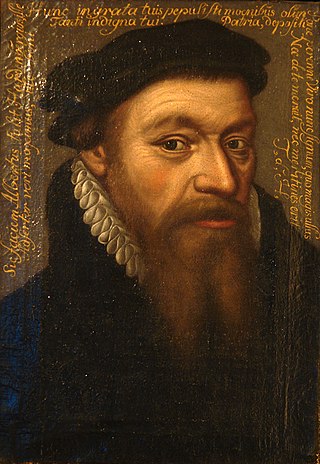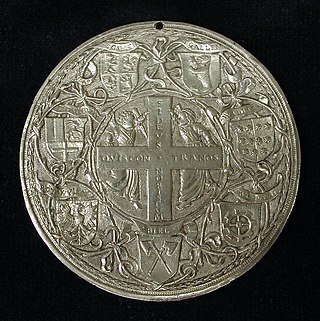
The House of Fugger is a German family that was historically a prominent group of European bankers, members of the fifteenth- and sixteenth-century mercantile patriciate of Augsburg, international mercantile bankers, and venture capitalists. Alongside the Welser family, the Fugger family controlled much of the European economy in the sixteenth century and accumulated enormous wealth. The Fuggers held a near monopoly on the European copper market.

John Frederick I, called the Magnanimous, was the Elector of Saxony (1532–1547) and head of the Schmalkaldic League.

Johann Georg Faust, also known in English as John Faustus, was a German itinerant alchemist, astrologer, and magician of the German Renaissance.

Matthäus Lang von Wellenburg was a statesman of the Holy Roman Empire, a Cardinal and Prince-Archbishop of Salzburg from 1519 to 1540.

Jörg Breu the Elder, of Augsburg, was a painter of the German Danube school. He was the son of a weaver.

Valerius Anshelm, born as Valerius Rüd, was a Swiss chronicler working in Bern.
Paulus Aemilius was a Hebrew bibliographer, publisher, and teacher associated with the University of Ingolstadt
Events from the year 1547 in art.
Events from the year 1510 in art.

Urbanus Henricus Rhegius or Urban Rieger was a Protestant Reformer who was active both in Northern and Southern Germany in order to promote Lutheran unity in the Holy Roman Empire. He was also a popular poet. Martin Luther referred to him as the "Bishop of Lower Saxony".

Ulrich Fuggervon der Lilie (1441–1510) was a German businessman of the Fugger family. He formally headed the family firm from his father's death in 1469 until his own death in 1510 after an operation to remove a bladder stone, though his business skills never matched those of his younger brother Jakob Fugger.

Johann von der Leyen (1510–1567) was the Archbishop-Elector of Trier from 1556 to 1567.

Albert Hardenberg or Albertus Risaeus was a Reformed theologian and Protestant reformer, who was also active as a reformer in Cologne, Bremen and Emden.

Elisabeth of Brandenburg was a Duchess consort of Brunswick-Göttingen-Calenberg by marriage to Eric I, Duke of Brunswick-Lüneburg, and Regent of the Duchy of Brunswick-Göttingen-Calenberg during the minority of her son, Eric II, Duke of Brunswick-Lüneburg, from 1540 until 1545. She is considered a "Reformation Princess", who, together with the Hessian reformer Anton Corvinus, helped the Reformation prevail in today's South Lower Saxony.

Anna of Brandenburg was a Duchess consort of Mecklenburg.
Johannes Salat was a Swiss chronicler, dramatist and mercenary.

Johann Jakob Fugger or Hans Jakob Fugger was a German banker and patron of the arts and sciences from the von der Lilie line of the noted Fugger banking family.

Hans Jakob Stampfer was a gold smith and medalist of Zürich in the age of Bullinger . He was the son of gold smith Hans Ulrich Stampfer and of Regula Funk and learned the same trade both from his father and during journeyman years in Germany, likely Augsburg. Stampfer returned to Zürich in 1531. He is recorded as a member of the Kämbel guild in 1533, and as the guild's representative in the city council in 1544. He acted as the city's assayer from 1539. Zürich issued a thaler coin minted by Stampfer, the so-called Stampfertaler, during 1555–1560. He married Margaretha von Schönau . He was reeve of Wädenswil during 1570 to 1577.
















